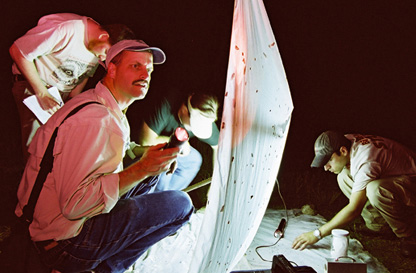
Research
 My principal research interests are in insect biosystematics and invertebrate conservation.
While my taxonomic publications have focused on leafminers (especially Gracillariidae), ghost moths (Hepialidae),
and various smaller efforts on other microlepidopterans, my students have worked with noctuids, choreutids, and others.
I have published more than two dozen papers and books on the immature stages of Lepidoptera.
Although most are taxonomic contributions, several address matters of larval ecology and behavior,
and I am becoming increasingly interested in using caterpillars to study tri-trophic interactions,
specialist-generalist diversity gradients, and larval polyphenism.
My principal research interests are in insect biosystematics and invertebrate conservation.
While my taxonomic publications have focused on leafminers (especially Gracillariidae), ghost moths (Hepialidae),
and various smaller efforts on other microlepidopterans, my students have worked with noctuids, choreutids, and others.
I have published more than two dozen papers and books on the immature stages of Lepidoptera.
Although most are taxonomic contributions, several address matters of larval ecology and behavior,
and I am becoming increasingly interested in using caterpillars to study tri-trophic interactions,
specialist-generalist diversity gradients, and larval polyphenism.
I have authored three identification guides to caterpillars of eastern North America,
and am nearing completion of a volume treating more than 800 species of eastern owlets (Noctuoidea).
A number of my recent manuscripts have focused on the systematic value of larvae in revealing previously unrecognized phylogenetic associations.
Collectively, members of my lab and a number of colleagues are gathering collections,
images, literature, and biological data that could be assembled into a volume on the caterpillars of western North America.
I am actively involved in research and policy matters relating to invertebrate conservation.
I recently co-authored (with Dale Schweitzer and Marc Minno) a book on
Rare, Declining, and Poorly Known Butterflies and Moths (Lepidoptera) of Forests and Woodlands in the Eastern United States
and a review on the Threats Posed to Rare or Endangered Insects by Invasions of Non-Native Species.
On-going research projects include pollinator faunistics and decline, species niche modeling,
the role of introduced parasitoids in the decline of native Lepidoptera, and assessing effects of introduced plants on imperiled butterflies.